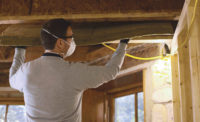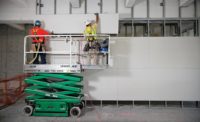When protecting commercial and multi-family buildings, where occupant rates range into the hundreds and cost millions to rebuild, fire protection tops the priority list of concerns for builders, owners and facility managers. It’s crucial to look beyond active fire protection, such as fire extinguishers, fire detectors and sprinkler systems and pay equal attention to the less-visible, passive fire protection systems that work to contain and compartmentalize fire and smoke and its point of origin.
Compartmentalization involves erecting barriers to divide a building into smaller units that will confine fire. This step helps to reduce risk and avoid reliance on any one element in a fire safety plan. Compartmentalization is critical because it limits where the fire can spread, while also complementing automatic sprinkler systems.
Fire partitions are an area of passive fire protection design that plays a significant role in minimizing the spread of fire damage and increasing occupant safety. Typically framed using cold-formed steel studs and tracks, these partitions, when properly installed with firestops, can provide the necessary protection.
Passive Firestop Systems
A critical component of any fire-rated wall assembly is the specified fire-stopping materials used to seal openings and joints. When installed properly, these products work in combination with the other components of the assembly to prevent the spread of fire, smoke and gasses through interior wall systems.
Traditional materials used in passive firestop systems include sealants, sprays, mechanical devices, intumescent materials and foam blocks or pillows. However, total fire protection cannot be achieved with the use of a singular product. Therefore, a system approach must be used when designing and specifying materials for constructing fire-rated wall assemblies. As such, it is not uncommon for general contractors to take responsibility for installing the firestop with their team of sub-contractors.
There are six primary types of openings or joints associated with fire and smoke resistive rated assemblies to which tested firestopping systems may be applied.
- Fire-resistant Joints: Joints between fire-rated construction components (e.g. head-of-wall, wall-to-wall, wall-to-floor, wall-to-ceiling)
- Penetrations: Openings containing mechanical, electrical, structural, security, piping or wiring
- Opening Protectives: A device for protecting an opening from the passage of flame, smoke, or hot gases
- Ducts and Air Transfer Openings: Where a duct or air transfer opening penetrates a fire-resistance-rated assembly
- Shaft Enclosures: When a shaft enclosure is chosen for the protection of an opening or penetration in a horizontal assembly, the shaft provides the protection from floor-to-floor fire migration
- Vertical Openings: Vertical openings for floor fire doors and access doors
It is recommended that contractors only use products with fire-resistance properties and performance verified by an accredited third-party testing agency.
Integrated Firestop Systems
One recent steel framing-related innovation is the integration of intumescent fire stop materials onto framing members. For commercial and institutional projects, architects and specifiers are now using steel tracks manufactured with a factory-metered dosage of intumescent applied in a controlled environment to the track flanges. These products help building and design professionals specify product and assembly solutions for both hidden and exposed aesthetic conditions where fire, smoke, and sound resistance ratings are required.
Single source construction of wall assemblies and installation of joint protection can now be achieved by drywall contractors, thereby eliminating any trade overlap issues that are common when installing traditional firestop materials. In addition, because the intumescent material comes pre-installed, it eliminates the need for the contractor to return to caulk at a later time.
The most popular advancement in the area of integrated firestop systems is BlazeFrame from ClarkDietrich. Designs using integrated systems like this product eliminate the need for caulks, sprays, drywall rips and contour drywall “castle” cuts throughout the joint systems. The factory-applied intumescent strip expands up to 35 times its size, allowing contractors to simultaneously frame, seal against fire and smoke and reduce airborne sound transmission through both dynamic and static joints. The cured intumescent is odor free, effective immediately, and remains unaffected by freezing, wet or humid conditions. BlazeFrame provides up to a 3-hour fire rating with dynamic and static joint protection for up to 1 inch.
Case Study: Integrated Passive Firestop Systems
New England Finish Systems LLC, of Salem, N.H., was tapped to install the exterior cladding, exterior and interior framing, and drywall of Riverview Suites, a six-story, 173,000-square-foot, new student residence hall at the University of Massachusetts, Lowell. Tasked with finishing all seven floors—five of which having 22 units a piece—in less than a year, the contractor was faced with a tight timeframe and budget. While the exterior framing and cladding portion of the project was comparatively straightforward, the contractor needed products that would help them meet the tight turnaround for the framing and construction of the building code-required, fire-rated interior wall assemblies.
The contractor usually used a combination of intumescent caulking and mineral fiber strips to seal head-of-wall joints and penetration openings in fire-rated wall assemblies. However, using this technique would add time and expense into the project.
“Our standard passive firestopping methods would have produced extra work for us on this project, with its non-typical flat metal roof and floor decking,” says Frank Murphy, general foreman for New England Finish Systems. “Plus, caulking is not cheap. Using them on a project of this scale and remaining within the project budget would have been difficult.”
After considerable research, their search led them to BlazeFrame, due to the performance and installation benefits of the product.
New England Finish Systems began the interior framing layout with a crew of three. One carpenter would install the BlazeFrame head of wall deflection tracks on each floor, and after HVAC ductwork was hung, the rest of the framing crew returned to construct the remainder of the wall assembly with 35/8-inch, the precut cold-formed steel studs. Stud spacing for interior walls and area separation firewalls was 16-inch on-center.
The crew found that product was easier and faster to install and a better fit for this installation than their typical firestopping methods. On average, the crew was able to complete a floor in a week’s time.
“Most of the time in buildings like this, you have steel I-beams spanned by corrugated steel decking, but the property owner preferred flat metal decking instead,” Murphy says.
All told, the project required 12,000 lineal feet of the 35/8-inch track, 500 lineal feet of expansion joint and 24,000, 4-feet by 9-feet sheets of 5/8-inch drywall.
Selecting the Right Materials
Selection of fire protection materials and methods is an important decision that should be carefully considered early in the design stage. While passive fire protection can successfully prevent the spread of fire, redundancy is key for total fire protection. New technologies, such as integrated firestop systems, save contractors time and money and help ensure the confinement of smoke and fire throughout commercial buildings. When combined with active fire protection systems, such as sprinklers, alarms and detection systems and occupant education, these materials offer a safer, more balanced approach to protecting a building and its occupants.
- Engineer of Record: TFMoran Inc.
- CFS Specialty Contractor: New England Finish Systems
- Architect of Record: Neshamkin French Architects
- General Contractor: Lee Kennedy Co Inc.






Report Abusive Comment